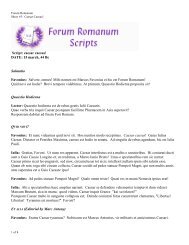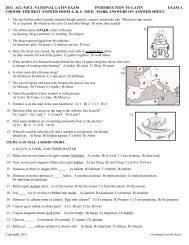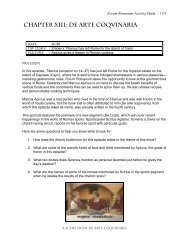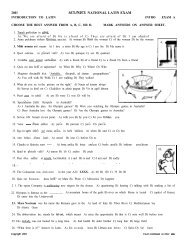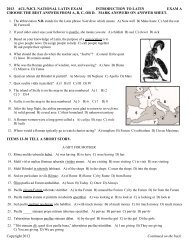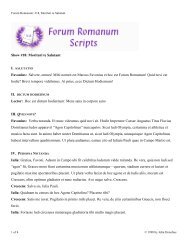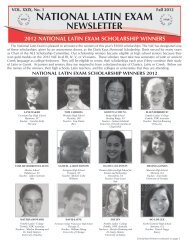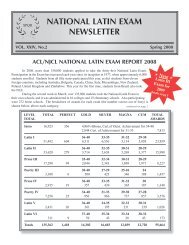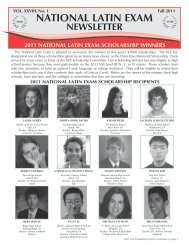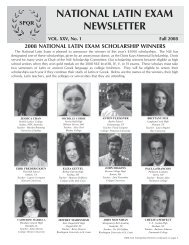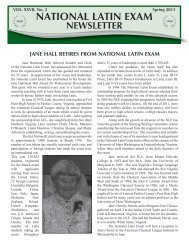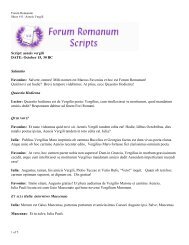2009 acl/njcl national latin exam introduction to latin intro exam a ...
2009 acl/njcl national latin exam introduction to latin intro exam a ...
2009 acl/njcl national latin exam introduction to latin intro exam a ...
Create successful ePaper yourself
Turn your PDF publications into a flip-book with our unique Google optimized e-Paper software.
26. When doc<strong>to</strong>rs in a hospital hear the abbreviated Latin word stat. over the loudspeaker, they should A) write<br />
prescriptions B) check patients’ charts C) consult a nurse D) come immediately<br />
27. Which Greek leader sacrificed his daughter at Aulis in order <strong>to</strong> appease the goddess Artemis and obtain favorable<br />
winds for sailing <strong>to</strong> Troy? A) Menelaus B) Agamemnon C) Nes<strong>to</strong>r D) Ulysses<br />
READ THE PASSAGE AND ANSWER THE QUESTIONS.<br />
A SECOND DEATH<br />
Eurydice, beloved wife of the famed musician Orpheus, has just been released from Hades by Plu<strong>to</strong> and Proserpina,<br />
rulers of the Underworld – but with one condition.<br />
Redditaque Eurydicē superās veniēbat ad aurās, 1<br />
pōne sequēns, namque hanc dederat Prōserpina lēgem, 2 pōne = behind<br />
cum subita incautum dēmentia cēpit amantem, 3 amantem = lover = Orpheus<br />
ignōscenda quidem, scīrent sī ignōscere mānēs. 4 ignōscenda = must be forgiven; mānēs = spirits of the dead<br />
Restitit Eurydicēnque suam iam lūce sub ipsā 5 Restitit = He (Orpheus) s<strong>to</strong>pped; sub = near <strong>to</strong><br />
immemor (heu!) victusque animī respexit. Ibi omnis 6<br />
effūsus labor atque immītis rupta tyrannī 7 effūsus = was wasted; immītis = harsh<br />
foedera, terque fragor stagnīs audītus Avernīs. 8 foedera = promises; fragor = crash<br />
Illa “Quis et mē,” inquit, “miseram et tē perdidit, Orpheu, 9<br />
quis tantus furor? Ēn iterum crūdēlia retrō 10 Ēn = behold<br />
Fāta vocant, conditque natantia lūmina somnus. 11 condit = covers<br />
Iamque valē.” 12<br />
Vergil, Georgics IV: 486-497<br />
28. In line 2, hanc...lēgem refers <strong>to</strong> A) the marriage of Orpheus and Eurydice B) the requirement of Prōserpina<br />
C) the commands of the Fates D) the laws of nature<br />
29. Line 3 contains an <strong>exam</strong>ple of A) chiasmus B) metaphor C) interlocked word order D) oxymoron<br />
30. In line 4, what do we learn about the spirits of the dead? A) they easily overlook laws of the Underworld<br />
B) Proserpina is <strong>to</strong> be ignored by them C) they may not be able <strong>to</strong> forgive D) Eurydice must pray <strong>to</strong> them<br />
31. In line 5, suam is best translated A) his own B) her own C) their own D) its own<br />
32. Why is Orpheus described as immemor in line 6? A) he no longer remembers how <strong>to</strong> play the lyre<br />
B) he has abandoned Eurydice C) he has failed <strong>to</strong> bring a <strong>to</strong>rch D) he has forgotten what Proserpina required<br />
33. The unders<strong>to</strong>od subject of respexit in line 6 is A) Eurydice B) Proserpina C) Plu<strong>to</strong> D) Orpheus<br />
34. In lines 7-8, rupta...foedera refers <strong>to</strong> A) Orpheus’ broken heart B) Eurydice’s distress C) Proserpina’s<br />
requirement D) the agreement of the spirits of the dead<br />
35. In line 8, fragor foreshadows A) Orpheus’ musical performance B) Plu<strong>to</strong>’s loud laughter<br />
C) Eurydice’s obligation <strong>to</strong> return <strong>to</strong> the Underworld D) Proserpina’s sudden outburst of weeping<br />
36. What is the scansion of the first four feet of line 8? A) DDSS B) DDSD C) DSSD D) DSDS<br />
37. Which figure of speech is found in lines 9-10? A) synecdoche B) anaphora C) alliteration D) li<strong>to</strong>tes<br />
38. In line 10, the words iterum and retrō reinforce the idea A) that Orpheus has broken an earlier promise<br />
B) that Eurydice has been filled once again with madness C) that Orpheus has been cruel before<br />
D) that Eurydice has been in the Underworld previously<br />
39. What direct object is unders<strong>to</strong>od with the phrase Fāta vocant (line 11)? A) me B) eum C) se D) eam<br />
40. In line 11, why does Eurydice describe her lūmina as natantia? A) she cannot bear the bright daylight<br />
B) she is weeping C) she must cross the River Styx D) she is drowning<br />
Copyright <strong>2009</strong>



